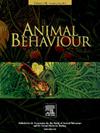社会传播在虎鲸对渔业的反应中使用新行为中的作用
IF 2.3
2区 生物学
Q2 BEHAVIORAL SCIENCES
引用次数: 0
摘要
人类的开发对生态系统产生了深远的影响,但也可以提供新的觅食机会,动物可能会通过学习新的觅食行为来做出反应。其中,以渔业捕获物或副产品为食,这种行为被称为“掠夺”,已在全球许多大型海洋捕食者物种中观察到。然而,对于社会性物种来说,社会传播如何影响种群内个体对这种行为的获得和参与程度,人们仍然知之甚少。在这项研究中,我们分析了18年(2005-2022年)的照片识别数据,结合了社会和扩散模型,以评估社会传播在克罗塞特群岛虎鲸种群的社会单位获得掠夺行为中的作用,以及社会单位一旦获得这种行为的程度。我们发现,随着时间的推移,越来越多的社会单位通过学习其他单位和独立学习获得了掠夺行为。我们还证明,在这种获取之后的几年里,它们参与掠夺的程度受到社会偏好的影响,密切相关的单位表现出相似的掠夺水平,某些单位作为结构关键节点,促进了网络内掠夺的传播。然而,在过去的一年里,当整个种群都获得了掠夺,我们发现除了社会传播之外的其他因素也在解释社会单位中观察到的掠夺水平的异质性。总之,这些发现突出了社会动态在塑造物种对人类引起的环境变化的反应中的作用,并导致种群内行为异质性,这可能对顶级海洋捕食者种群的长期保护产生重大影响。本文章由计算机程序翻译,如有差异,请以英文原文为准。
The role of social transmission in the use of a new behaviour by killer whales in response to fisheries
Human exploitation profoundly impacts ecosystems but can also provide novel feeding opportunities to which animals may respond by learning new foraging behaviours. Among these, feeding on fisheries catch or byproduct, a behaviour termed ‘depredation’, has been observed in many large marine predator species globally. However, for social species, how social transmission influences both the acquisition of and the level of engagement in such behaviour by individuals within populations remains poorly understood. In this study, we analysed 18 years (2005–2022) of photo-identification data, with a combination of both social and diffusion models, to assess the role of social transmission in the acquisition of depredation by social units of the killer whale population of the Crozet Islands, as well as the extent to which social units engaged in this behaviour once acquired. We found that an increasing number of social units acquired depredation behaviour over time and that they did so through learning from other units and independent learning. We also demonstrate that during the years following this acquisition, their level of engagement in depredation was influenced by social preferences, with closely associated units showing similar levels of depredation and certain units acting as structural key nodes facilitating the transmission of depredation within the network. However, past the year when the entire population had acquired depredation, we found that factors other than social transmission came into play to explain heterogeneity in depredation levels observed across social units. Together, these findings highlight the role of social dynamics in shaping species' response to human-induced changes in their environment and in leading to intrapopulation behavioural heterogeneity that can have major implications for the long-term conservation of top marine predator populations.
求助全文
通过发布文献求助,成功后即可免费获取论文全文。
去求助
来源期刊

Animal Behaviour
生物-动物学
CiteScore
4.60
自引率
8.00%
发文量
236
审稿时长
10.2 weeks
期刊介绍:
Growing interest in behavioural biology and the international reputation of Animal Behaviour prompted an expansion to monthly publication in 1989. Animal Behaviour continues to be the journal of choice for biologists, ethologists, psychologists, physiologists, and veterinarians with an interest in the subject.
 求助内容:
求助内容: 应助结果提醒方式:
应助结果提醒方式:


